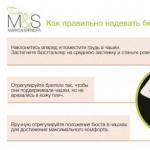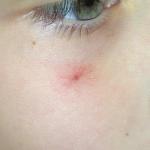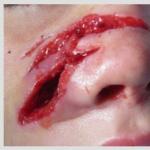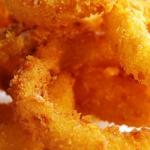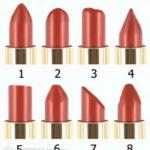The People's Friendship Fountain is one of the distinctive features of VDNKh. Fountain “Friendship of the Peoples of the USSR Fountain with golden statues in a circle
Fountain Friendship of Peoples or Friendship of the Peoples of the USSR- a fountain opened in 1954 at VDNKh.

The history of the Friendship of Peoples fountain at VDNKh
The Fountain of Friendship of Peoples was built in 1954 according to the design of the architect-artist K. T. Topuridze, engineer V. I. Klyavin and sculptors Z. V. Bazhenova, A. I. Teneta, I. M. Chaikov, Z. V. Ryleeva and V.P. Gavrilov.
The fountain is built in the center of the square, which was formerly called Kolkhoz Square and was transformed as part of the creation of new republican pavilions.
In the original project it was called as "Main Fountain", there are also names "Golden Sheaf" And "Friendship of the Peoples of the USSR".
Description of the fountain “Friendship of Peoples”
The oval bowl of the fountain is topped with a golden sheaf of wheat, industrial hemp and sunflowers, woven into a large sheaf. Around the sheaf are statues of 16 gilded girls, symbolizing the 16 union republics of the USSR at that time (the Karelo-Finnish Republic was later “downgraded” to the status of the Autonomous Soviet Socialist Republic). The girls are holding in their hands the agricultural plant that was most often grown in the fields of her native republic.
Fountain sculptures
Representatives of these republics posed for the sculptors of the People's Friendship Fountain. Now the names of only three models are known: the Estonian ballerina Virve Kiple-Parsadanyan, the Turkmen Gozel Annamamedova and the Georgian Rodam Amirejibi.
The Republic girls are in the following order:
- RSFSR
- Ukrainian SSR
- Uzbek SSR
- Georgian SSR
- Lithuanian SSR
- Latvian SSR
- Tajik SSR
- Turkmen SSR
- Karelo-Finnish SSR
- Estonian SSR
- Armenian SSR
- Moldavian SSR
- Kirghiz SSR
- Azerbaijan SSR
- Kazakh SSR
- Byelorussian SSR
The prototype of the sculptures of the “Friendship of Peoples” fountain was Stepan Pimenov’s “Guriev Service” of 1809-1816, with gilded porcelain sculptures.
The fountain has the shape of an oval: its size along the major axis is 81 meters, and along the minor axis - 56 meters. The perimeter length is 170 meters. Area - 3723 sq. m. In one second, 1200 liters of water are thrown upward.
At night, the fountain is beautifully illuminated, changing sixteen times in one hour.
Built in 1954 according to the design of architects K. Topuridze and G. Konstantinovsky. By the way, the fountain has 16 female figures representing 16 republics of the USSR. The 16th republic is the Karelo-Finnish Republic, which in 1956 was turned into the Karelian ASSR as part of the RSFSR.
STORY
The original name of the fountain was “Golden Sheaf” (renamed just before the opening of the exhibition in August 1954).
Authors - K.T. Topuridze and G.D. Konstantinovsky. The design and hydraulic parts were developed under the guidance of engineer V.I. Klyavina, and the electrical engineering part was carried out by the Mossvetproekt design office (V.I. Sokolov). The decorative and sculptural design of the fountain was made by sculptors 3.V. Bazhenova, A.I. Teneta, I.M. Tchaikov and Z.V. Ryleeva. The sheaf was sculpted by V.P. Gavrilov.
According to the project of 1950-1951. a square in front of the statue of Stalin was planned at this place, and the fountain was supposed to be installed opposite the pavilion of the Ukrainian Republic (on the site of the “Stone Flower”). Architects K. Topuridze and G. Konstantinovsky, design engineers L. Shoikhet and B. Novikov, hydraulic engineers A. Vetkin and L. Kesler and electrical engineer N. Volpyan took part in the development of this option.
"GOLDEN SHAP"
The theme of the abundance of socialist agriculture formed the basis of the compositional design of the Golden Sheaf fountain. Its pool in plan follows the shape of an octagonal area, in the center of which a fountain is placed, and is an elongated octagon with internal dimensions along the major axis of 81 m and along the minor axis - 56 m.
The length of the perimeter of the pool is 170 m, and its area, as mentioned above, is 3,723 square meters. m. The side of the pool is lined with massive slabs of red polished granite.
In the center of the pool, above the water surface, rises a large decorative golden sheaf of the main agricultural crops of our Motherland. The sheaf is made of copper leaves by beating into metal forms. It is surrounded by 16 bronze, gilded sculptures of collective farm girls, representing the 16 Union Soviet republics. These sculptures are installed on 16 granite pedestals.
A whole system of jets rises above the central decorative group, forming a sheaf of water of impressive size. It exceeds 20 m in height.
The central part of the fountain has 6 main jet patterns and 25 intermediate ones. The patterns of the jets gradually alternate, changing the overall composition of the fountain.
The central fountain group is flanked along the elongated axis of the pool by two small fountain groups, each of which consists of two concentric rings of supply pipes with nozzles decorated along the outer rings with decorative flowers of two types (24 in each ring). The attachments of the inner rings are decorated with decorative fish (8 on each ring). Fishes and flowers are made of copper sheets using the hammering method.
In addition, there are four pairs of decorative dolphins installed in the pool; 8 longitudinal jets fly out of their mouth.
Changing the shapes of fountain jets is carried out automatically.
The total duration of the fountain's closed cycle is one and a half hours.
In the evening, the fountain is illuminated according to a set program that runs automatically. The change of colors is linked to variations in the play of fountain jets. About 250 floodlights have been installed for this purpose.
An extensive pumping station is located in the central part of the pool, under the decorative design of the fountain. Its premises are connected by an underground tunnel to the basement of the Russian Federation pavilion, where a transformer station serving the fountain is located.
The 8 pumps located in the pumping station are driven by electric motors with a total power of 550 kW. Every second, 880 fountain nozzles throw out 1.2 thousand liters of water. This water is sucked in by the pumps through the water intake chamber that surrounds the pumping station and released again in the form of fountain jets.
The design of the pool consists of a reinforced concrete bottom and side walls that form one whole. The central part of the fountain is an oval in plan, built along two radii. The dimensions in plan are 21.3 m along the major axis, and 16.32 m along the minor axis. The area of the pumping station is 262 sq. m. m.
A decorative sheaf 7.4 m high is placed above the central part of the pumping station (its height from the finished floor reaches 5.66 m).
The central part of the fountain in section has a stepped appearance and is divided into separate cascades with a decrease from the center. Around the base of the sheaf there is a first chamber illuminating the jets, glazed over metal frames with stalinite 1.29 m wide.
This is followed by an upper cascade of variable width from 1.6 m to 2.13 m, which is a reinforced concrete tank. The cascade has a circular closed shape in plan. Its sides are decorated with copper decorative cuts. The lower wall of the cascade is lined with red polished granite. The depth of water in the cascade is 85-90 cm.
Below the upper cascade there is a second illumination chamber, also glazed with stalinite. Underneath it there is a middle reinforced concrete cascade 1.15-1.7 m wide. Its front wall is lined with torn red granite, and a pattern-shaped forged granite slab is laid on top of it. There are 16 cast iron sinks installed along the perimeter of the cascade wall.
From the second - middle - cascade, water flows into cast iron sinks, and from there it flows into the lower cascade. From here the water flows over the side into the pool. The front wall of the lower cascade is also lined with torn granite, and its side is decorated with decorative copper cutting.
Created in 1954. Architect - K.T. Topuridze, engineer - V.I. Klyavina, sculptors - Z.V. Bazhenova, A.I. Teneta, I.M. Chaikov, Z.V. Ryleeva, V.P. Gavrilov.
Current state
The fountain is working.
Geometry, mathematics, engineering
The fountain has an oval geometry: its size along the major axis is 81 m, and along the minor axis 56 m. The length along the perimeter is 170 m. The area is 3723 sq. m. m.
Castling of fountains
The “Friendship of Peoples” fountain is located in the south-eastern oval part of the vast square of the same name (until 1954 it was called Kolkhoz Square), directly being one of its artistic and semantic accents. Initially, on the same site of the All-Russian Agricultural Exhibition in 1939, there was a children's cafe and part of the southern recreation area, which included several small pavilions. During the post-war reconstruction of 1949–1954, due to the need to create new republican pavilions, it was decided to build them along a single central axis, visually connecting Meshchanskaya Street (Mira Avenue) and the All-Russian Agricultural Exhibition. The old wooden pavilions were demolished, and a square for holding rallies was designed on the vacated territory.
In the scheme of the updated planning structure under the leadership of A.F. Zhukov and R.R. Kliksa, this part of the Exhibition was conceived in the form of a three-ray, the axes of which would converge at one point - to the new monument to I.V. Stalin, designed on the site where the floral parterre of the Stone Flower fountain now begins. Just in front of this monument, facing the Main Pavilion, an octagonal, elliptical-shaped square with a lowered central part, like a Roman stage-arena, was supposed to be. Already during the construction work, the artistic council of the All-Russian Agricultural Exhibition came to the conclusion that this site for meetings was inappropriate - and it was decided to place another Main fountain in the center of the created space. It was based on the project of the first Main Fountain at the Ukraine Pavilion, already being implemented at that time. The original fountain, “demoted” from the former to the latter, was reworked by the same authors K.T. Topuridze and G.D. Konstantinovsky - and so the “Stone Flower” blossomed.
Classicism
The architectural design of the fountain fit perfectly into both the layout and the image of the Exhibition as a whole. “Friendship of Peoples” in its entirety reminds us of the most famous examples of fountain art of the 17th–18th centuries. The stepped, oval bowl of the fountain is topped with a golden sheaf of wheat, industrial hemp and sunflowers, woven into a huge sheaf. He is surrounded by 16 gilded bronze girls, personifying the 16 union republics that were part of the USSR at that time. Representatives of these republics posed for the sculptors of the round dance fountain. The names of only three models are known: the Estonian ballerina and actress Virve Kiple-Parsadanyan, the Turkmen pianist Gozel Annamamedova and the wife of the poet Mikhail Svetlov, the Georgian Rodam Amirejibi.
In addition to the national background, there is undoubtedly a mythological one. It is no coincidence that the images of the girls resemble Demeter, the goddess of fertility, the patroness of agriculture, since Soviet art of the 1930s–1950s was aligned with the aesthetic ideals of classicism.
Konstantin Topuridze, as a subtle connoisseur and interpreter of the classical heritage, when creating “Friendship of Peoples,” was clearly guided by the masterpieces of Peter the Great’s era; the appearance of the fountain is very similar to the Peterhof prototypes, right down to the reproduction of individual elements - dolphins. It is interesting that the authors of the fountain did not immediately come to a laconic solution based on a combination of red granite and gilded bronze, since initially all the figures, with the exception of the sheaf, were intended to be polychrome, that is, lined with colored smalt. Oddly enough, in 1954 it was the classic choice of the authors that was criticized, earning praise as “merchant cheapness”, “16 samovars”, etc. Recognizing the artistic successes achieved by the authors of the fountain, domestic art critic V.P. Tolstoy noted: “The figures of the girls are devoid of decorativeness and monumentality, which are necessary for perception in the open air in such a vast space.<…>They are deprived of the plastic expressiveness of the silhouettes, and being covered with gilding, which further destroyed their plastic volume due to the fact that it gleams strongly in the sun, this completely neutralized their national originality, and the figures themselves, which in theory constitute a friendly round dance, are not sufficiently connected with each other . As a result, the very good poetic idea of the “Friendship of Peoples” fountain did not receive a sufficiently vivid figurative embodiment.” .
Composition
There are opinions that the prototype of the fountain was Stepan Pimenov’s “Guriev Service” of 1809–1816 - his porcelain sculptures resembled ancient goddesses with national features in clothing and attributes, just like the characters of Alexei Venetsianov, who worked in the same years. Unlike his academic contemporaries, the artist looked for his ideal of female beauty among peasant women. Against the backdrop of a realistic Russian landscape, his semi-fantastic characters - ancient goddesses in national festive clothes - harrow the earth, and then relax in the shade of trees in the poses of Titian's beauties.
1. Until the summer of 2017, the fountains operated in a truncated mode - the automatic jet input did not work. But when all the fountains were working at full capacity at the Exhibition, the fountain was serviced by about 30 people! The play of jets was achieved using a technique that even today may seem fantastic to many. Imagine a wall ten meters high, on which motor relays hang in four rows - such “alarm clocks” with many arrows. These relays provided the movement and closure of contacts, which in turn turned on various electrical devices. The latter set the pumps and valves in motion, all this was synchronized. There was completely contact automation, not only without computer technology, but even without semiconductors. All this, naturally, had to be constantly cleaned, washed, and freed from dust. That’s why so many people worked, Alexander Egorov, technical director of VDNKh JSC, said in an interview with Moscow-24 in 2014 .
Pchelov E.V. VSKhV, Moscow metro and Soviet symbols // Auxiliary and special sciences of history in the 20th - early 21st centuries: vocation, creativity, public service of a historian. Materials of the XXVI International Conference. M.: RSUH, 2014. P. 301.
Transcript of the meeting of the Board and sections of the Moscow Union of Soviet Artists on November 19, 1954.
Http://www.m24.ru/articles/56873 .
- Other names: Friendship of the Peoples of the USSR
- Date of construction: 1954
- Architect, sculptor, restorer: Konstantin Topuridze, sculptors: Z. V. Bazhenova, L. A. Bazhanova, A. I. Teneta, Z. V. Ryleeva, I. M. Chaikov.
- Address: VDNH, near the central pavilion
- Coordinates: 37°37′54.44″E; 55°49′47.39″N
One of the main attractions of VDNKh - the Friendship of Peoples fountain, symbolizing the abundance of socialist agriculture, was opened on August 1, 1954 on Kolkhoz Square (now Friendship of Peoples Square) of VDNKh.
Initially it was planned to be called the “Golden Sheaf”, but just before the opening it was renamed. Previously, the fountain was called "Friendship of the Peoples of the USSR", but over time the last word fell away.
The fountain was created according to the design of the architect-artist K. T. Topuridze, engineer V. I. Klyavin and a team of sculptors Z. V. Bazhenova, A. I. Teneta, I. M. Chaikov, Z. V. Ryleeva and V. P. Gavrilova.
The structure is a sculptural composition, where in the middle there is a golden sheaf made of copper leaves depicting agricultural crops - rye, sunflower and hemp. Around the sheaf are sixteen bronze sculptures of collective farm girls, covered with gold leaf, representatives of the Union republics.
If you look at the fountain clockwise from the Main Pavilion, you will get the following sequence: RSFSR; Ukrainian SSR; Uzbek SSR; Georgian SSR; Lithuanian SSR; Latvian SSR; Tajik SSR; Turkmen SSR; Karelo-Finnish SSR; Estonian SSR; Armenian SSR; Moldavian SSR; Kirghiz SSR; Azerbaijan SSR; Kazakh SSR; Byelorussian SSR. That is, the republics are not located in the same order as on the coat of arms of the USSR.
If you walk from the Main Pavilion, then in the foreground of the fountain are the three Slavic republics of the USSR. A girl with a braid on her head, holding wheat in her hands, personifying Russia, stands in the center overlooking the Main Pavilion, and the fraternal Slavic republics - a girl in a wreath - Ukraine and Belarus - a girl in a headscarf - stand on the sides (from left to right: Ukraine, Russia , Belarus). The sculptures are installed on 16 granite pedestals.
It is noteworthy that during the creation of the sculptures, representatives of nationalities corresponding to each republic posed.
In 1954, the number of union republics within the USSR was 16. However, in 1956 the republics became fifteen, but the sculpture of the girl of the Karelo-Finnish SSR (girl with a Christmas tree) was left, since it was almost impossible to remake the fountain at that time. The coat of arms of the Karelo-Finnish SSR is still painted over on the façade of the Main Pavilion.
The "Round Dance of the Republics" is located in a pool, which is an elongated octagon (81 m along the major axis and 56 m along the minor axis). The sides of the pool are lined with massive slabs of red polished granite.
The water column above the central part of the decorative group of the fountain reached the height of a six-story building (up to 24 meters). Every second, about 2000 fountain nozzles threw out 1.2 thousand liters of water. But recently, the height of the jets has been significantly reduced due to wear and tear of the fountain’s pumping station. The station is located under the central part of the fountain and is connected by an underground tunnel to pavilion 71, where in the basement there is a transformer station and an automation system that serves the fountain.
An impressive spectacle takes place here in the evening. 250 spotlights illuminate the fountain according to a set program, which changes sixteen times in one hour. The change of colors corresponds to the system of playing fountain jets.
The Fountain “Friendship of Peoples” is one of the main symbols not only of VDNKh, but of the whole of Moscow; in 2014 it celebrated its 60th anniversary.
The fountain was originally called the “Golden Sheaf”, as it was intended to reflect the theme of abundance of socialist agriculture. However, the name “Friendship of Peoples,” which it received literally on the eve of its opening, was still more in keeping with its content. Today it is quite obvious that the fountain has outlived its original ideological meaning, as has happened more than once in history with works of true artistic value. The grandiose structure - a historical and cultural monument of national importance - was built in 1954 according to the design of architects K. Topuridze and G. Konstantinovsky. The decorative and sculptural design was made by Z. Bazhenova, A. Teneta, I. Tchaikov and Z. Ryleeva. The sheaf was sculpted by V. Gavrilov. The design and hydraulic parts were developed under the guidance of engineer V. Klyavin.
It is noteworthy that during the creation of the sculptures, representatives of nationalities corresponding to each republic posed. Only three heroines are known who posed for the fountain sculptors. These are the Estonian ballerina and actress Virve Kiple-Parsadanyan, the Turkmen pianist Gozel Annamamedova, who was a student at the Moscow Conservatory in those distant years, and the Georgian wife of the poet Mikhail Svetlov Rodam Amirejibi.
The water column above the central part of the decorative group of the fountain reaches a height of 24 meters. Every second, about 2000 fountain nozzles threw out 1.2 thousand liters of water. The pumping station is located under the central part of the fountain and is connected by an underground tunnel to pavilion No. 71, where the transformer station and automation system servicing the fountain are located. The surface area of the water mirror of the Friendship of Peoples fountain, framed by an octagonal bowl made of red granite, is about 4000 square meters. meters, size along the major axis is 81 m, along the minor axis - 56 m, depth - 70 cm. The total duration of the closed cycle of the fountain’s operation is one and a half hours.
“Friendship of Peoples” is the largest of the cascade of fountains at the All-Russian Exhibition Center, which includes 14 fountains on the Central Alley, the poetic composition of the “Stone Flower” fountain, inspired by Bazhov’s Ural fairy tales, and the “Golden Ear” fountain. In the center of “Friendship of Peoples” is a gigantic sheaf of abundance from the main agricultural crops of the former USSR. The sheaf is made of copper leaves by beating into metal forms. Around him in a silver cascade of jets are 16 sculptural figures of collective farm girls in national costumes, personifying the 16 Soviet republics. The sixteenth was the sculpture of the Karelo-Finnish SSR, which in 1956 was returned to the status of an autonomous republic within the RSFSR. The sculptures are made of bronze and covered with the thinnest layer of gold. The sheaf is made of copper and also covered with gold.
An impressive spectacle takes place here in the evening. 250 spotlights illuminate the fountain according to a set program, which changes sixteen times in one hour. The change of colors corresponds to the system of playing fountain jets.
Walking around the “Friendship of Peoples” fountain, trying to understand which girl symbolizes which republic is a pleasure that can captivate you for a long time, especially if you have some idea about national costumes and what agricultural crops each republic was famous for.
My family and I really like to walk around historical places and learn something new.

